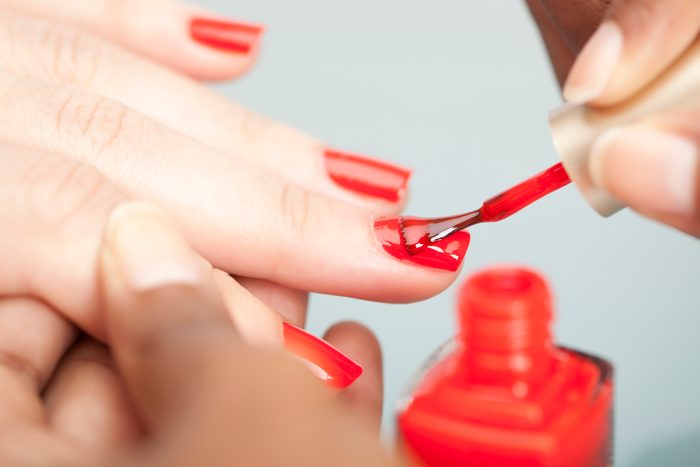
(Dirty) little nail salon secrets
For some people, going for a fresh mani and pedi is a treat-yourself moment. For others, a trip to the nail salon can be a cause for panic—which is the best nail polish, how much do you tip at the nail salon, what’s the difference between gel and dip powder and what are polite habits nail techs actually dislike? Finding a new salon that you trust can be tough. After all, there are a lot of boxes to check and a ton of nail salon red flags to look out for.
The ideal spot should be clean, focus on hygiene, have good reviews and have nail technicians who are proven to make your manicure last longer. But if you’ve never been there, how can you be sure it’s good? Just like there are red flags of a bad hair salon, over-the-top red flags exist at nail salons as well. Here’s what to look for.
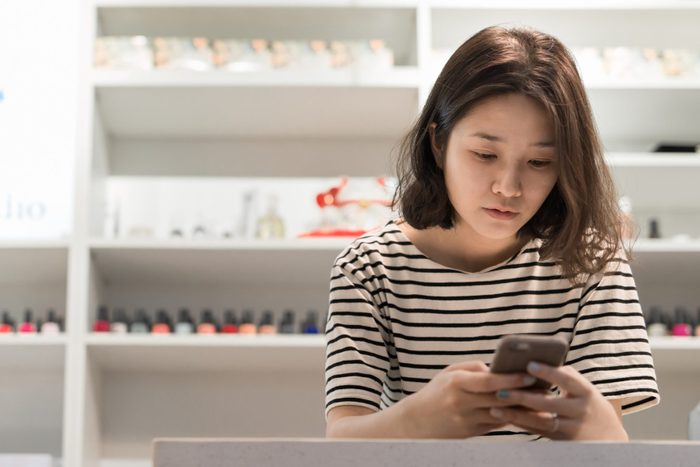
The reviews are all bad
The internet can be a great place to suss out whether or not a nail salon is worth your time. That said, you probably know that reviews should be taken with a grain of salt because everyone has different opinions and priorities. However, if a nail salon has a super low rating (think one or two stars) and the bad reviews hit on the exact same thing—maybe they all mention that it’s super dirty or the nail techs are rude—that’s a big nail salon red flag.
What to look for: No need to stress too much about a bad review or two, especially if they’re somewhat subjective (like a customer didn’t enjoy the music being played or was mad they didn’t have a super niche color for someone’s dream spring nails). Ideally, the good reviews should outweigh the bad. If a spot has an average of four stars or above, that tends to be a good sign.
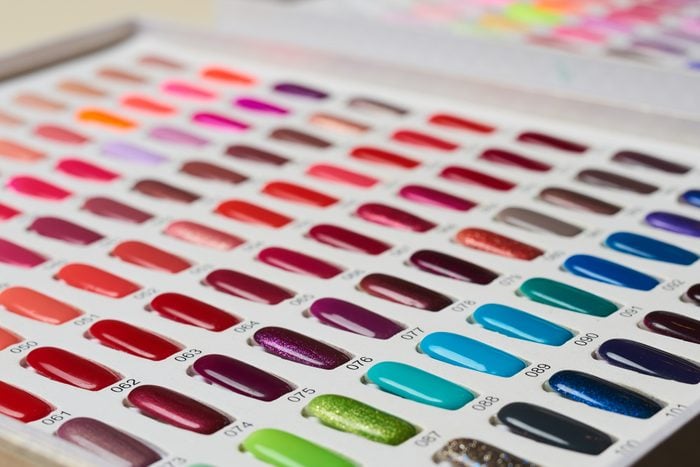
Certifications aren’t available
Nail technicians must be certified. And while many nail salons display these in frames near the front desk, don’t panic if you don’t see them right away. “You can also always ask to see certifications before sitting down or picking your polish,” says Rachel Apfel Glass, founder of Glosslab, a nail salon with 20 locations in the United States. If you ask and they can’t provide proof of certification, that’s a major problem and a red flag for a nail salon. At that point, consider doing your manicure at home.
What to look for: Nail tech certification varies by state. For example, nail techs in New York should have a Nail Specialty License, which means they have completed a 27-hour nail trainee course and passed written and practical exams, says Glass. Other states may require more or less practical training and exams. Regardless, all states require a certain amount of education, training and testing before getting an official license. You can find out what is required in your state with a quick online search.
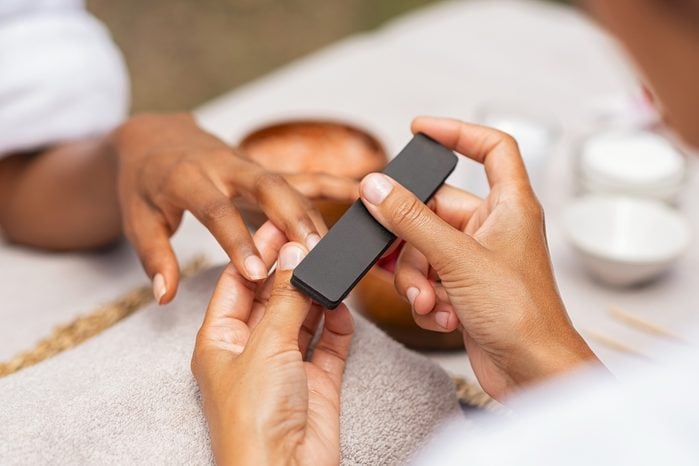
They don’t sterilize tools
Picture this: You sit down for your appointment and your nail tech picks up the exact same cuticle scissors she just used on her previous client. If tools haven’t been decontaminated, that’s a big problem and a major nail salon red flag, confirms Glass, who notes that hospital-grade sterilization should be used on metal nail tools. If they aren’t properly cleaned, bacteria can easily spread and cause infections.
What to look for: There are a few ways salons may sanitize metal tools between customers. Some may submerge tools within a disinfecting liquid. Others prefer devices that use extremely high temperatures to kill bacteria. “You can ask if a tool is clean and how they clean it,” says Molly Romah, the lead nail technician at Chillhouse, a self-care spa in New York City. “You should also look at the tool to see if it has visible signs of being dirty or used.”
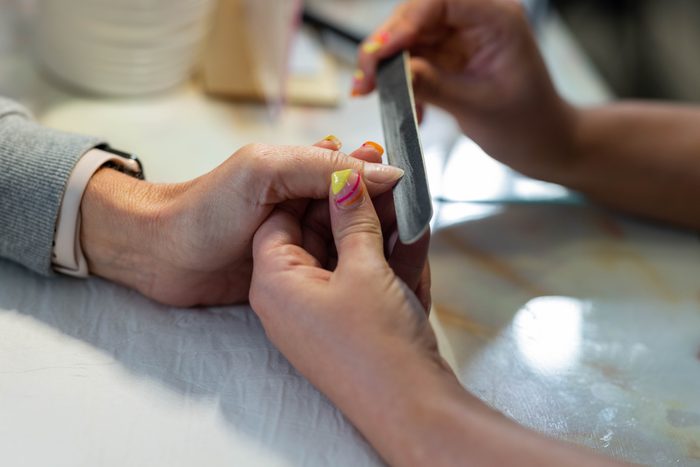
They use the same file over and over
Not all tools can be sanitized. Specifically, nail files, buffers and pumice stones. These items shouldn’t be reused as they can hold and spread bacteria, says Glass. Because they are porous, germs can easily multiply, and many states even have laws that require salons to use a new file with each person. So if your nail tech brings out a file that looks beat up and used, that is unacceptable and a big red flag.
What to look for: “Only tools that can be disinfected should be kept,” says Romah. When you walk in and are waiting for your turn, pay attention to what the nail techs are doing with nail files, buffers and pumice stones. If you see them bring out a new option or see them toss a file after using it, that’s a good sign.
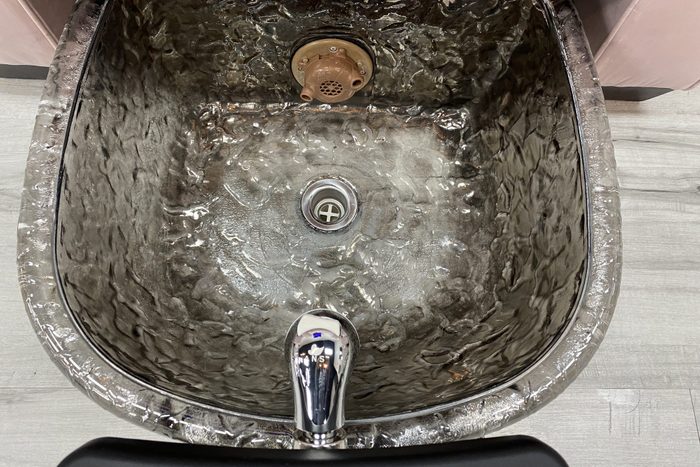
Pedicure tubs aren’t super clean
DIY pedicures are great, but is there anything better than a relaxing pedicure at a salon? That is, unless you sink your tootsies into a tub of bacteria-laden water. “Water is a breeding ground for germs—and even if water is simply dumped and then replaced, germs still linger,” says Glass. Jetted pedicure tubs are particularly prone to growing bacteria because they have lots of nooks and crannies that are tough to clean properly and quickly.
What to look for: More and more salons are moving away from jetted tubs for that reason. Some salons are using plastic liners in those tubs before filling them with water so they can replace the liner after each customer. Others, like the one Glass founded, do waterless pedicures to avoid any possibility of water-related bacteria. If your salon does use pedicure tubs without liners, make sure they use a disinfectant spray, scrub with soap and rinse the tub with water, says Romah.
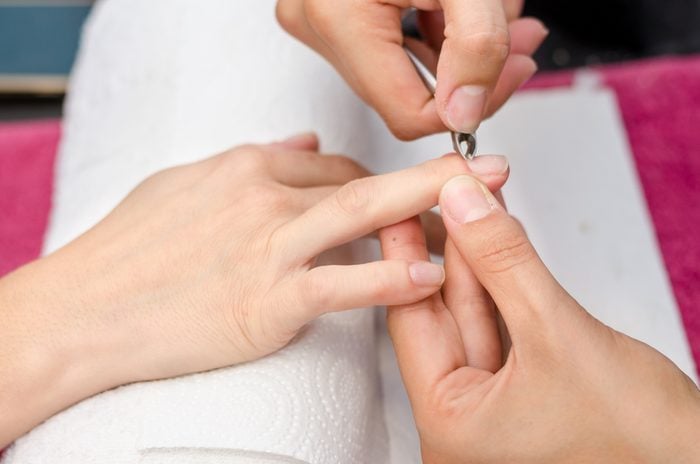
Cuticles aren’t carefully cut
To cut or not to cut—your cuticles that is. The truth is: Experts don’t agree on this very controversial topic, so it really comes down to personal preference. What experts do agree on is that a nail tech who is careless when cutting cuticles is no good. “Cutting cuticles can risk infection, exposing your skin to potentially harmful bacteria,” says Glass. And the less careful someone is, the more likely they are to cut you and expose you to infection.
What to look for: Take note if your nail tech is talking to someone else or not looking at what they’re doing while they’re working on your cuticles. It’s also better if they’re more conservative when they cut, especially if they have just soaked your nails in a little bowl of water. Water-soaked cuticles are bigger, so if they’re trimmed too much, it can result in peeling when they shrink back to normal size, says Glass. After trimming a bit off, they should follow up with cuticle oil to protect your nail bed.

Polish is removed haphazardly
A sanding tool should never, ever be used to grind away regular nail polish. The same goes for a nail file. If one of these tools is used, it’s a big nail salon red flag, as it can damage your nails and leave them weaker. On that note, if you have regular polish on, a nail tech shouldn’t soak your nails for a long period of time in acetone either. While this type of remover is effective, it is also very strong and can soften your nails and lead to peeling or breakage. Only a quick swipe is needed for regular polish.
What to look for: A nail tech should reach for a straightforward polish remover to take off polish. “In the salon we use pure acetone to remove polish,” says Romah. “You can also use non-acetone, it just takes a bit longer than pure acetone.”

They suggest you remove your own gel
Often, when you call a salon to make an appointment, they’ll ask if you currently have on gel nail polish. This is because they’ll have to build in extra time for your tech to remove it. If they ask you to remove it yourself before you come in, that’s a nail salon red flag. “When someone tries to remove their [gel] polish at home, it is very likely that they’ll end up thinning their nail or peeling layers of the nail, leaving it very sensitive,” says Karina Medrano, a licensed cosmetologist and nail technician at Elle B. Savvy in Denver. A nail tech should know this and never ask you to do the work yourself.
What to look for: A nail salon should build in extra time for your appointment if you have told them you have gel on your nails—just know, they’ll likely charge a small removal fee, since it is labor intensive. When you arrive, your tech should take care to remove gel properly. They may use a file to lightly create some abrasions in your gel. This will help acetone sink in and remove the gel. From there, they will likely wrap an acetone-soaked cotton ball around each nail and let it sit for 5 to 10 minutes before wiping away the polish.
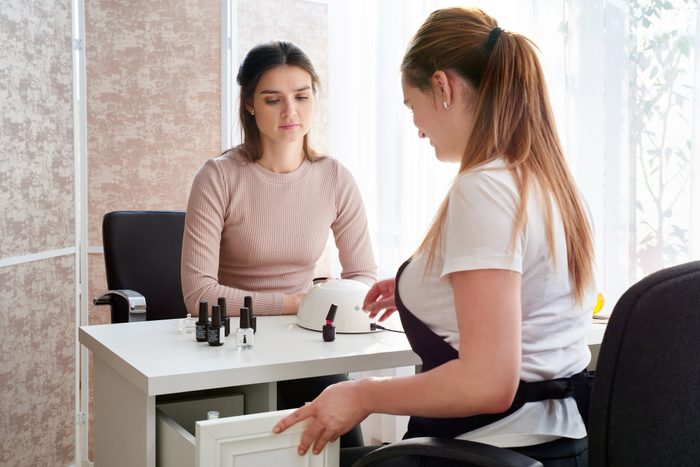
You get bossed around
A trip to the salon is a great way to treat yourself to some rest and relaxation. But if a tech is bossing you around, it can feel tense and irritating. Even if the tech is busy and has back-to-back appointments, they should never bark orders at you or tell you to hurry up and pick your nail polish. The same applies for dictating what you get done. If you tell them you want a basic pedicure and they get pushy, telling you to get the upgraded package, it may not be the best spot for you.
What to look for: Bossy is bad and a red flag for nail salons. However, being direct is not. You should never feel bullied or pushed around—that’s not professional, says Medrano. But a tech who states clearly what she needs you to do or what she would suggest is actually a great quality because it helps prevent miscommunication.
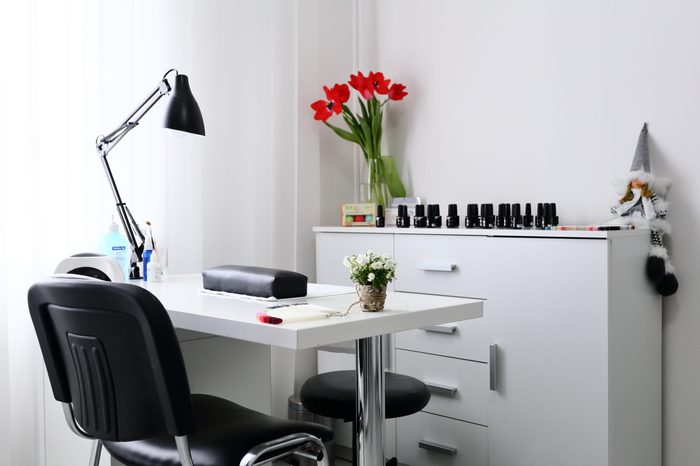
Their nail station is a mess
Old nail clippings, dust from previous nail filings, food wrappers or stains, a spilled bottle of base coat—all those are major red flags at nail salons, and none of it should be lingering at a nail tech’s station. If a station is not clean, it puts you at risk for picking up bacteria. It’s also a sign that they don’t prioritize cleanliness, which is important when someone is working with your hands.
What to look for: It’s part of our job to keep up with the mess and stay tidy, says Medrano. To that end, when you sit down at a station, it should feel clean and well organized. A tech shouldn’t have to sort through a ton of junk to find what they need.
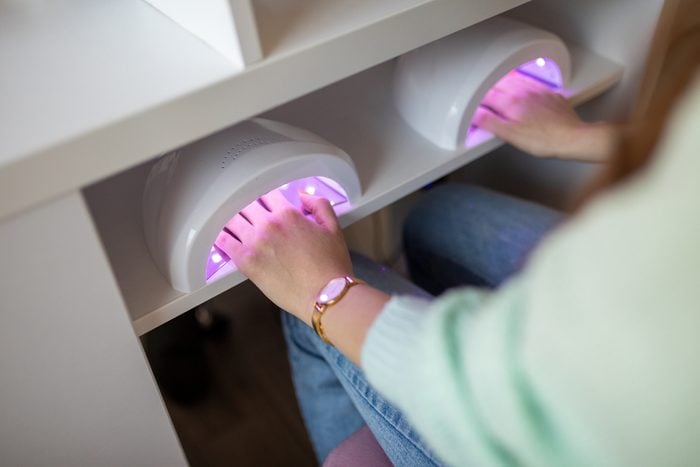
You do the heavy lifting
Your nail tech does not work for you, but you are paying them for a service. Part of that means you want to feel taken care of and pampered. If a tech isn’t helping you move your bag when you’re headed to the drying station or watches you struggle to get out of your chair without smudging your top coat, it may be a nail salon red flag. We are here to help our clients, so helping to carry bags or shoes to the drying station should be no problem, says Medrano.
What to look for: Little things can go a long way in making you feel pampered and relaxed. Are you offered water when you sit down? Is a nail tech pulling out your chair and escorting you to the drying station? These are small signs that the salon values its customers and wants to do the best job possible.
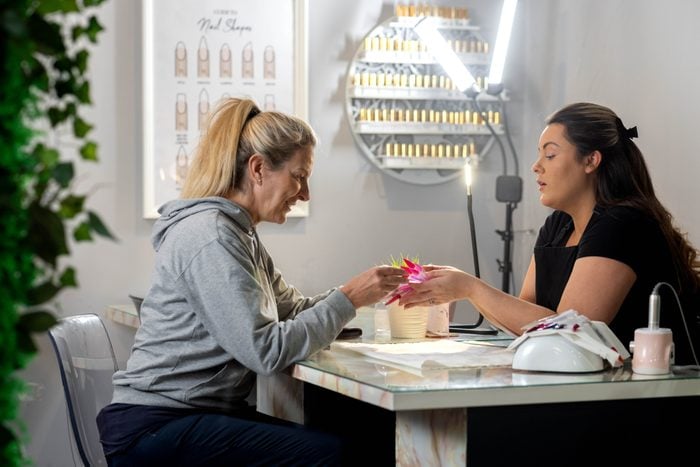
They don’t listen to you
You ask for rounded nails and the nail tech gives you square. You say you don’t want your cuticles cut, and they do it anyway. You ask for only one coat of polish and they do two. These are signs that a tech isn’t listening to you, which is unacceptable.
What to look for: Collaboration is key. They are the professional, but you are the paying customer—and the one who has to live with the manicure or pedicure. You may ask for their opinion on trendy nail polish colors, or they may give you feedback on nail shape based on their experience, but it’s ultimately up to you. At the end of the day, what is done to your nails should be your choice, says Medrano.
Sources:
- Rachel Apfel Glass, founder of Glosslab, nail salon with 20 locations in the United States
- Molly Romah, lead nail technician at Chillhouse in New York City
- Karina Medrano, licensed cosmetologist and nail technician at Elle B. Savvy in Denver
